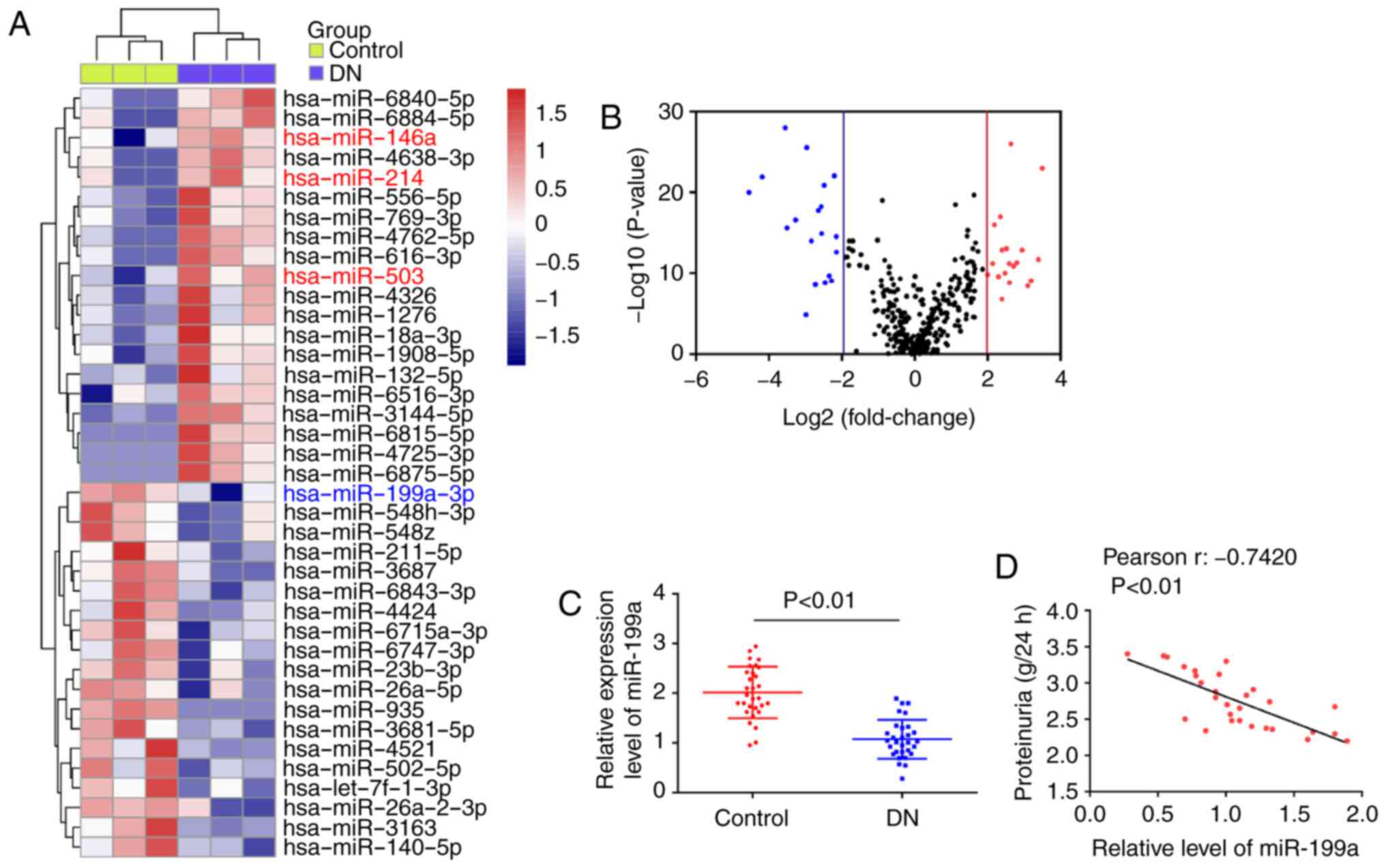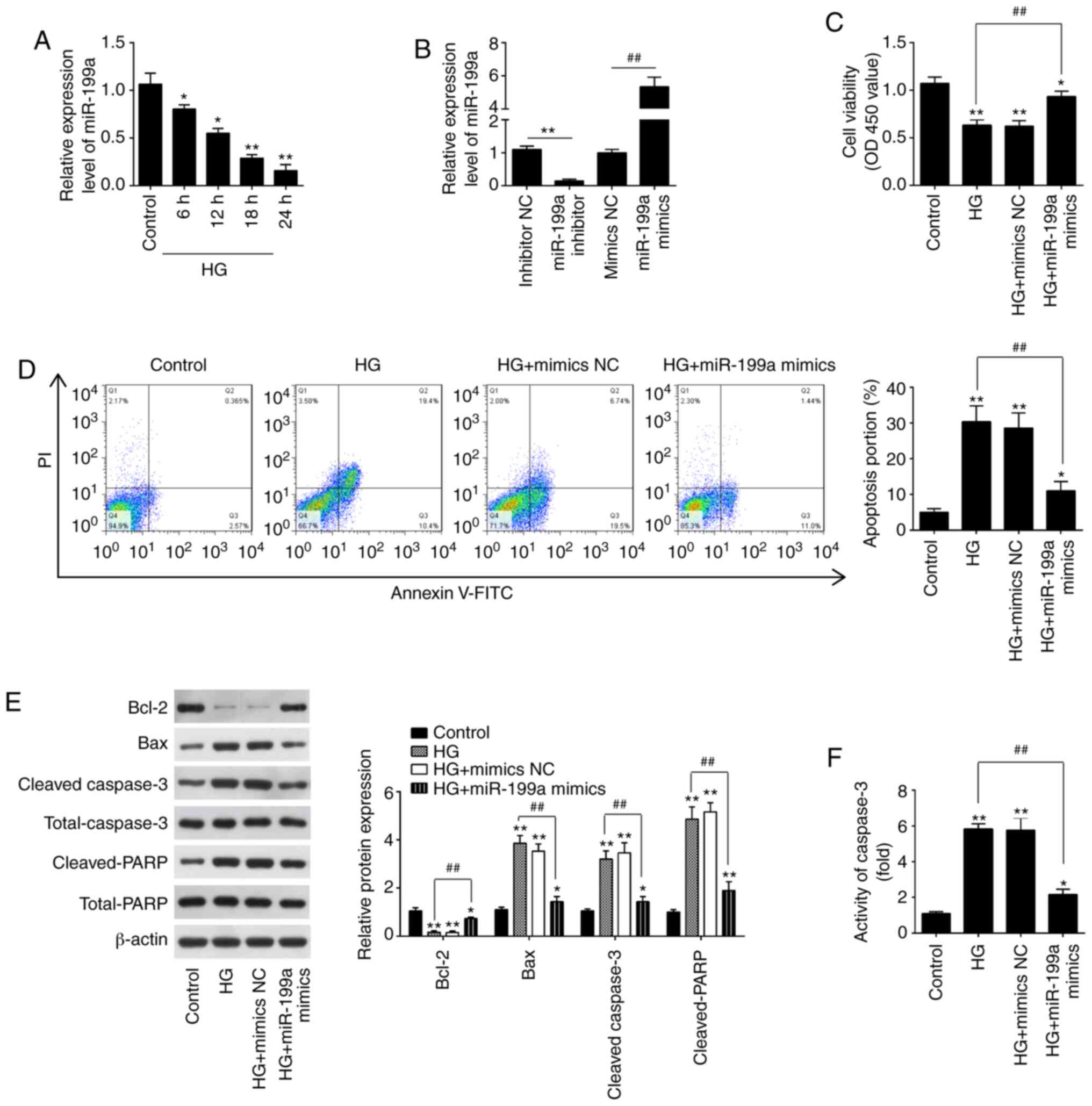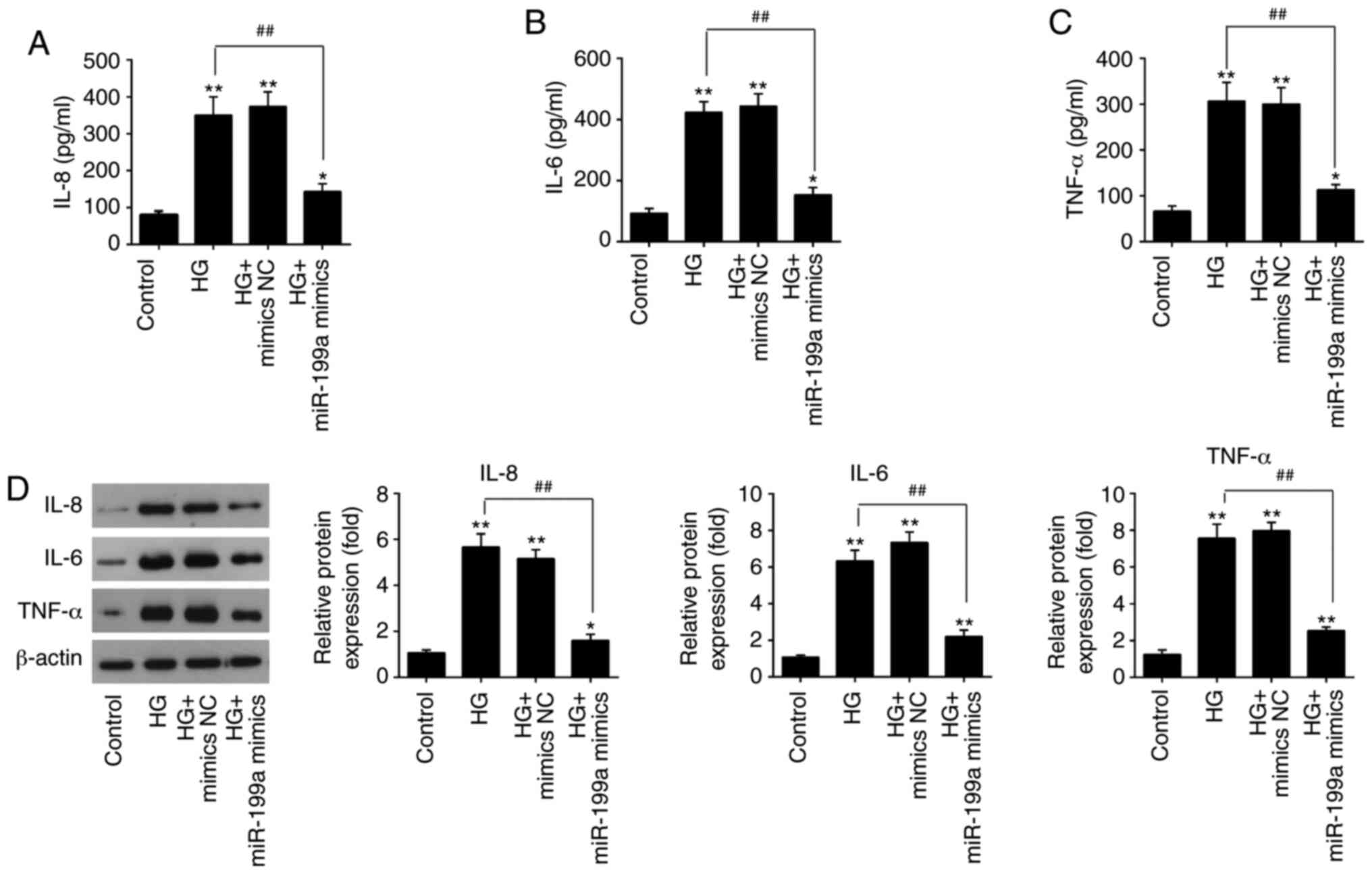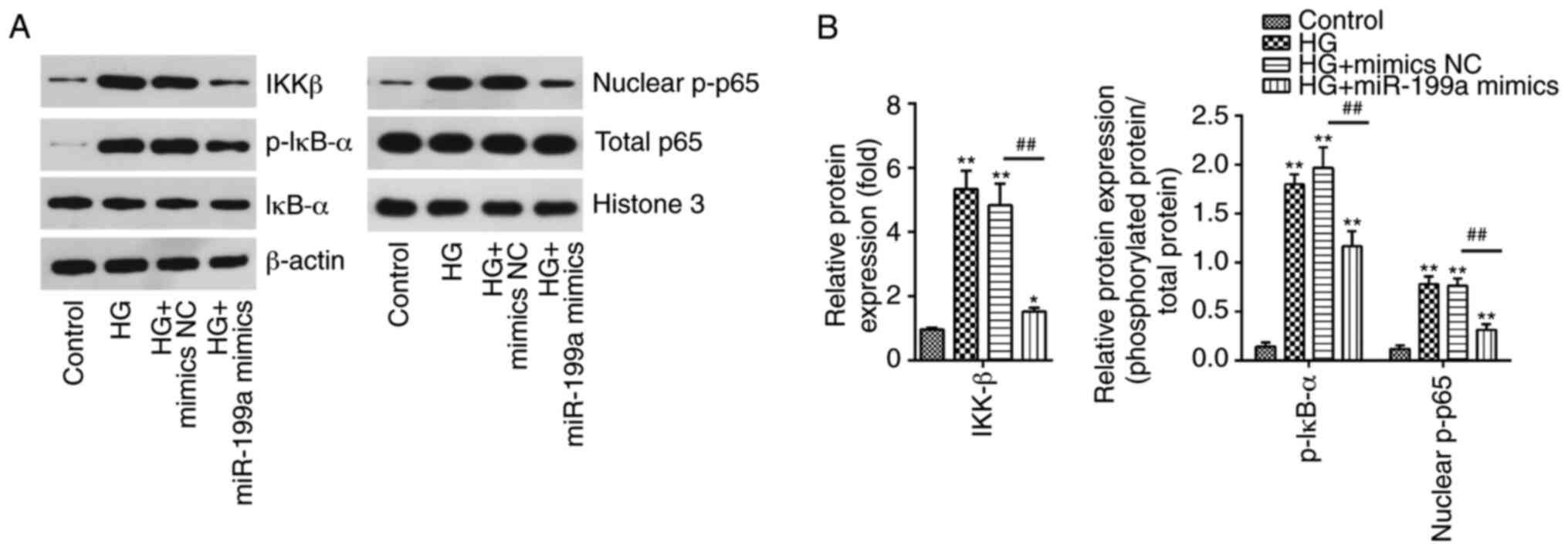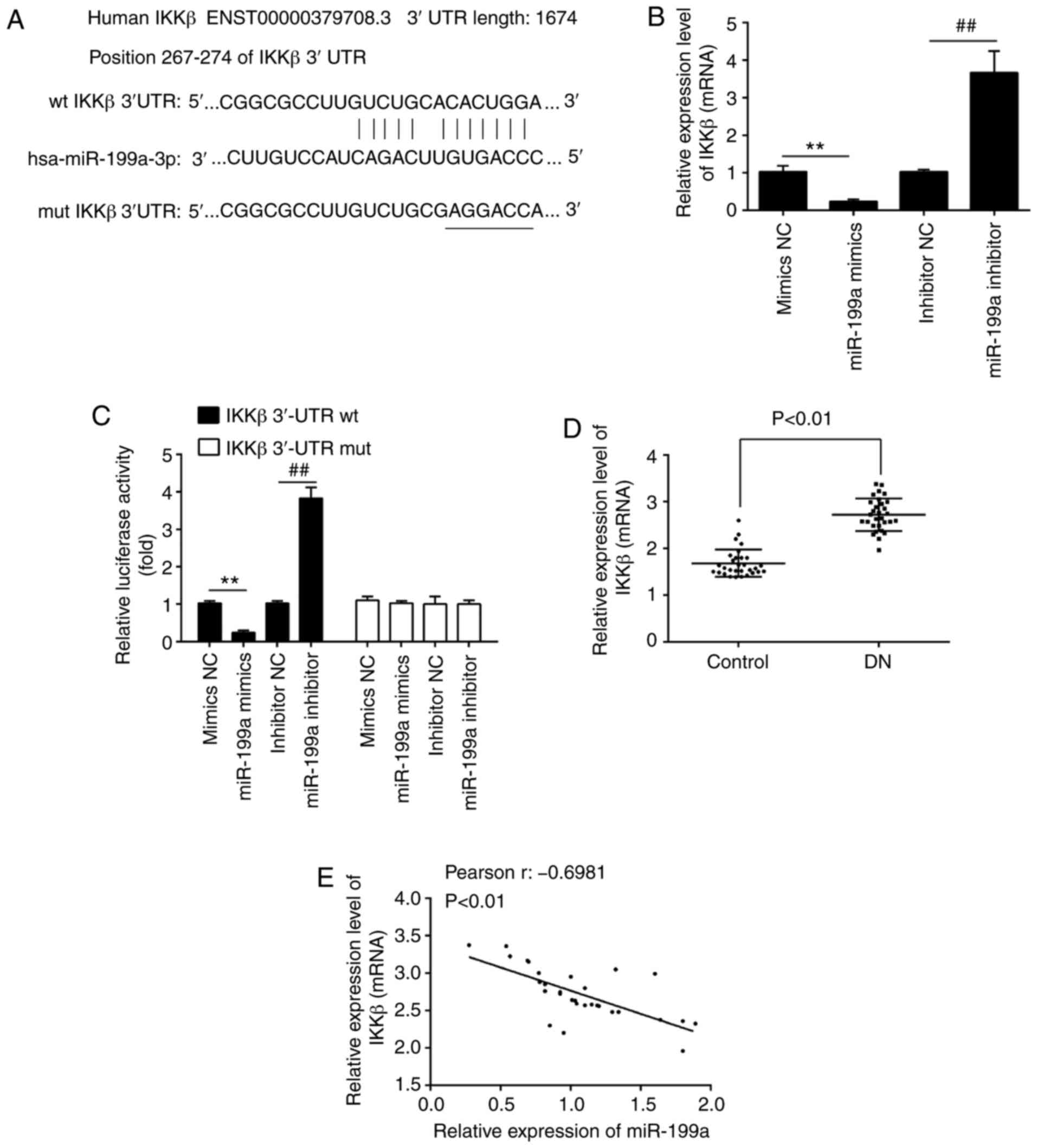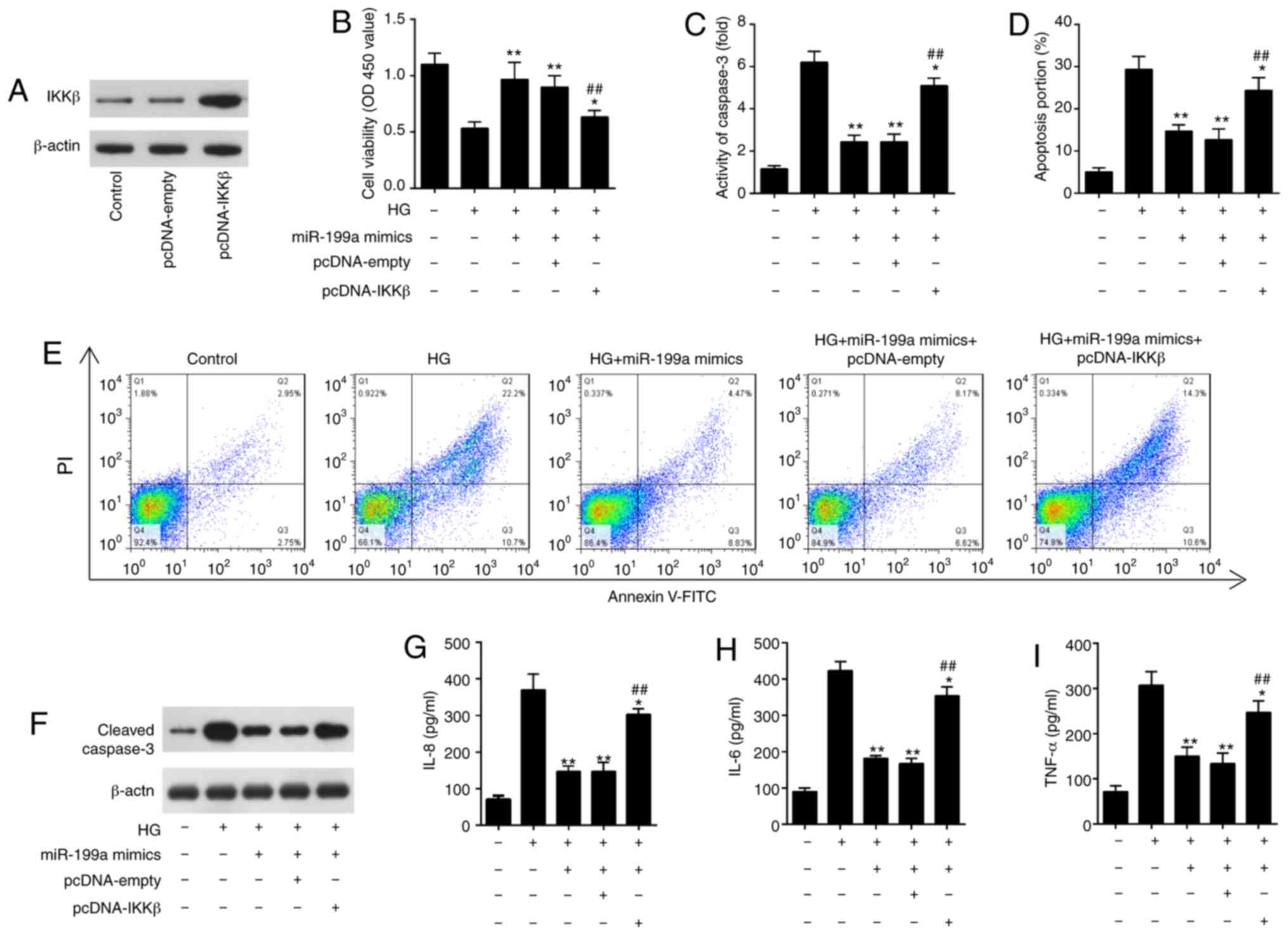|
1
|
Umanath K and Lewis JB: Update on diabetic
nephropathy: Core curriculum 2018. Am J Kidney Dis. 71:884–895.
2018. View Article : Google Scholar : PubMed/NCBI
|
|
2
|
Verzola D, Gandolfo MT, Ferrario F,
Rastaldi MP, Villaggio B, Gianiorio F, Giannoni M, Rimoldi L,
Lauria F, Miji M, et al: Apoptosis in the kidneys of patients with
type II diabetic nephropathy. Kidney Int. 72:1262–1272. 2007.
View Article : Google Scholar : PubMed/NCBI
|
|
3
|
Magri CJ and Fava S: The role of tubular
injury in diabetic nephropathy. Eur J Intern Med. 20:551–555. 2009.
View Article : Google Scholar : PubMed/NCBI
|
|
4
|
Li T and Cho WC: MicroRNAs: Mechanisms,
functions and progress. Genomics Proteomics Bioinformatics.
10:237–238. 2012. View Article : Google Scholar : PubMed/NCBI
|
|
5
|
Zhu FX, Wu HL, Chen JX, Han B and Guo YF:
Dysregulation of microRNA-181b and TIMP3 is functionally involved
in the pathogenesis of diabetic nephropathy. J Cell Physiol.
234:18963–18969. 2019. View Article : Google Scholar : PubMed/NCBI
|
|
6
|
Bhatt K, Lanting LL, Jia Y, Yadav S, Reddy
MA, Magilnick N, Boldin M and Natarajan R: Anti-inflammatory role
of MicroRNA-146a in the pathogenesis of diabetic nephropathy. J Am
Soc Nephrol. 27:2277–2288. 2016. View Article : Google Scholar :
|
|
7
|
Deshpande SD, Putta S, Wang M, Lai JY,
Bitzer M, Nelson RG, Lanting LL, Kato M and Natarajan R:
Transforming growth factor-β-induced cross talk between p53 and a
microRNA in the pathogenesis of diabetic nephropathy. Diabetes.
62:3151–3162. 2013. View Article : Google Scholar : PubMed/NCBI
|
|
8
|
Long J, Wang Y, Wang W, Chang BH and
Danesh FR: Identification of microRNA-93 as a novel regulator of
vascular endothelial growth factor in hyperglycemic conditions. J
Biol Chem. 285:23457–23465. 2010. View Article : Google Scholar : PubMed/NCBI
|
|
9
|
Wang J, Gao Y, Ma M, Li M, Zou D, Yang J,
Zhu Z and Zhao X: Effect of miR-21 on renal fibrosis by regulating
MMP-9 and TIMP1 in kk-ay diabetic nephropathy mice. Cell Biochem
Biophys. 67:537–546. 2013. View Article : Google Scholar : PubMed/NCBI
|
|
10
|
Li H, Zhu X, Zhang J and Shi J:
MicroRNA-25 inhibits high glucose-induced apoptosis in renal
tubular epithelial cells via PTEN/AKT pathway. Biomed Pharmacother.
96:471–479. 2017. View Article : Google Scholar : PubMed/NCBI
|
|
11
|
Li X, Zeng L, Cao C, Lu C, Lian W, Han J,
Zhang X, Zhang J, Tang T and Li M: Long noncoding RNA MALAT1
regulates renal tubular epithelial pyroptosis by modulated miR-23c
targeting of ELAVL1 in diabetic nephropathy. Exp Cell Res.
350:327–335. 2017. View Article : Google Scholar
|
|
12
|
Lau GJ, Godin N, Maachi H, Lo CS, Wu SJ,
Zhu JX, Brezniceanu ML, Chénier I, Fragasso-Marquis J, Lattouf JB,
et al: Bcl-2-modifying factor induces renal proximal tubular cell
apoptosis in diabetic mice. Diabetes. 61:474–484. 2012. View Article : Google Scholar : PubMed/NCBI
|
|
13
|
Huang YF, Zhang Y, Liu CX, Huang J and
Ding GH: microRNA-125b contributes to high glucose-induced reactive
oxygen species generation and apoptosis in HK-2 renal tubular
epithelial cells by targeting angiotensin-converting enzyme 2. Eur
Rev Med Pharmacol Sci. 20:4055–4062. 2016.PubMed/NCBI
|
|
14
|
Su J, Ren J, Chen H and Liu B:
MicroRNA-140-5p ameliorates the high glucose-induced apoptosis and
inflammation through suppressing TLR4/NF-κB signaling pathway in
human renal tubular epithelial cells. Biosci Rep.
40:BSR201923842020. View Article : Google Scholar
|
|
15
|
Lv L, Zhang J, Tian F, Li X, Li D and Yu
X: Arbutin protects HK-2 cells against high glucose-induced
apoptosis and autophagy by up-regulating microRNA-27a. Artif Cells
Nanomed Biotechnol. 47:2940–2947. 2019. View Article : Google Scholar : PubMed/NCBI
|
|
16
|
Wang GJ, Jiao BP, Liu YJ, Li YR and Deng
BB: Reactivation of microRNA-506 inhibits gastric carcinoma cell
metastasis through ZEB2. Aging (Albany NY). 11:1821–1831. 2019.
View Article : Google Scholar
|
|
17
|
Kohl M, Wiese S and Warscheid B:
Cytoscape: Software for visualization and analysis of biological
networks. Methods Mol Biol. 696:291–303. 2011. View Article : Google Scholar
|
|
18
|
Livak KJ and Schmittgen TD: Analysis of
relative gene expression data using real-time quantitative PCR and
the 2(-Delta Delta C(T)) method. Methods. 25:402–408. 2001.
View Article : Google Scholar
|
|
19
|
Ding Y, Wang L, Zhao Q, Wu Z and Kong L:
MicroRNA93 inhibits chondrocyte apoptosis and inflammation in
osteoarthritis by targeting the TLR4/NFkB signaling pathway. Int J
Mol Med. 43:779–790. 2019.
|
|
20
|
Wang X, Shen E, Wang Y, Li J, Cheng D,
Chen Y, Gui D and Wang N: Cross talk between miR-214 and PTEN
attenuates glomerular hypertrophy under diabetic conditions. Sci
Rep. 6:315062016. View Article : Google Scholar : PubMed/NCBI
|
|
21
|
Zha F, Bai L, Tang B, Li J, Wang Y, Zheng
PX, Ji T and Bai S: MicroRNA-503 contributes to podocyte injury via
targeting E2F3 in diabetic nephropathy. J Cell Biochem.
120:12574–12581. 2019. View Article : Google Scholar : PubMed/NCBI
|
|
22
|
Chen YY, Peng XF, Liu GY, Liu JS, Sun L,
Liu H, Xiao L and He LY: Protein arginine methyltranferase-1
induces ER stress and epithelial-mesenchymal transition in renal
tubular epithelial cells and contributes to diabetic nephropathy.
Biochim Biophys Acta Mol Basis Dis. 1865:2563–2575. 2019.
View Article : Google Scholar : PubMed/NCBI
|
|
23
|
Ni WJ, Tang LQ and Wei W: Research
progress in signalling pathway in diabetic nephropathy. Diabetes
Metab Res Rev. 31:221–233. 2015. View Article : Google Scholar
|
|
24
|
Yu C, Qi D, Sun JF, Li P and Fan HY: Rhein
prevents endotoxin-induced acute kidney injury by inhibiting NF-κB
activities. Sci Rep. 5:118222015. View Article : Google Scholar
|
|
25
|
Yang X, Wang Y and Gao G: High glucose
induces rat mesangial cells proliferation and MCP-1 expression via
ROS-mediated activation of NF-κB pathway, which is inhibited by
eleutheroside E. J Recept Signal Transduct Res. 36:152–157. 2016.
View Article : Google Scholar
|
|
26
|
Wang G, Yan Y, Xu N, Hui Y and Yin D:
Upregulation of microRNA-424 relieved diabetic nephropathy by
targeting rictor through mTOR complex2/protein kinase B signaling.
J Cell Physiol. 234:11646–11653. 2019. View Article : Google Scholar : PubMed/NCBI
|
|
27
|
Yang S, Fei X, Lu Y, Xu B, Ma Y and Wan H:
miRNA-214 suppresses oxidative stress in diabetic nephropathy via
the ROS/Akt/mTOR signaling pathway and uncoupling protein 2. Exp
Ther Med. 17:3530–3538. 2019.PubMed/NCBI
|
|
28
|
Bai X, Geng J, Zhou Z, Tian J and Li X:
MicroRNA-130b improves renal tubulointerstitial fibrosis via
repression of Snail-induced epithelial-mesenchymal transition in
diabetic nephropathy. Sci Rep. 6:204752016. View Article : Google Scholar : PubMed/NCBI
|
|
29
|
Phatak P, Burrows WM, Chesnick IE,
Tulapurkar ME, Rao JN, Turner DJ, Hamburger AW, Wang JY and Donahue
JM: MiR-199a-3p decreases esophageal cancer cell proliferation by
targeting p21 activated kinase 4. Oncotarget. 9:28391–28407. 2018.
View Article : Google Scholar : PubMed/NCBI
|
|
30
|
Liu J, Liu B, Guo Y, Chen Z, Sun W, Gao W,
Wu H and Wang Y: MiR-199a-3p acts as a tumor suppressor in clear
cell renal cell carcinoma. Pathol Res Pract. 214:806–813. 2018.
View Article : Google Scholar : PubMed/NCBI
|
|
31
|
Qu F, Zheng J, Gan W, Lian H, He H, Li W,
Yuan T, Yang Y, Li X, Ji C, et al: MiR-199a-3p suppresses
proliferation and invasion of prostate cancer cells by targeting
Smad1. Oncotarget. 8:52465–52473. 2017. View Article : Google Scholar : PubMed/NCBI
|
|
32
|
Callegari E, D'Abundo L, Guerriero P,
Simioni C, Elamin BK, Russo M, Cani A, Bassi C, Zagatti B,
Giacomelli L, et al: miR-199a-3p modulates MTOR and PAK4 pathways
and inhibits tumor growth in a hepatocellular carcinoma transgenic
mouse model. Mol Ther Nucleic Acids. 11:485–493. 2018. View Article : Google Scholar : PubMed/NCBI
|
|
33
|
Li L, Mou YP, Wang YY, Wang HJ and Mou XZ:
miR-199a-3p targets ETNK1 to promote invasion and migration in
gastric cancer cells and is associated with poor prognosis. Pathol
Res Pract. 215:1525112019. View Article : Google Scholar : PubMed/NCBI
|
|
34
|
Dai BH, Geng L, Wang Y, Sui CJ, Xie F,
Shen RX, Shen WF and Yang JM: microRNA-199a-5p protects hepatocytes
from bile acid-induced sustained endoplasmic reticulum stress. Cell
Death Dis. 4:e6042013. View Article : Google Scholar : PubMed/NCBI
|
|
35
|
Tao Y, Zhang H, Huang S, Pei L, Feng M,
Zhao X, Ouyang Z, Yao S, Jiang R and Wei K: miR-199a-3p promotes
cardiomyocyte proliferation by inhibiting Cd151 expression. Biochem
Biophys Res Commun. 516:28–36. 2019. View Article : Google Scholar : PubMed/NCBI
|
|
36
|
Rane S, He M, Sayed D, Vashistha H,
Malhotra A, Sadoshima J, Vatner DE, Vatner SF and Abdellatif M:
Downregulation of miR-199a derepresses hypoxia-inducible
factor-1alpha and Sirtuin 1 and recapitulates hypoxia
preconditioning in cardiac myocytes. Circ Res. 104:879–886. 2009.
View Article : Google Scholar : PubMed/NCBI
|
|
37
|
Zuo Y, Wang Y, Hu H and Cui W:
Atorvastatin protects myocardium against ischemia-reperfusion
injury through inhibiting miR-199a-5p. Cell Physiol Biochem.
39:1021–1030. 2016. View Article : Google Scholar : PubMed/NCBI
|
|
38
|
Liu Y, Guan H, Zhang JL, Zheng Z, Wang HT,
Tao K, Han SC, Su LL and Hu D: Acute downregulation of miR-199a
attenuates sepsis-induced acute lung injury by targeting SIRT1. Am
J Physiol Cell Physiol. 314:C449–C455. 2018. View Article : Google Scholar : PubMed/NCBI
|
|
39
|
Wang W, Guo Z, Yang S, Wang H and Ding W:
Upregulation of miR-199 attenuates TNF-α-induced human nucleus
pulposus cell apoptosis by downregulating MAP3K5. Biochem Biophys
Res Commun. 505:917–924. 2018. View Article : Google Scholar : PubMed/NCBI
|
|
40
|
Li M, Luan L, Liu Q, Liu Y, Lan X, Li Z
and Liu W: MiRNA-199a-5p protects against cerebral ischemic injury
by down-regulating DDR1 in rats. World Neurosurg. 131:e486–e494.
2019. View Article : Google Scholar : PubMed/NCBI
|
|
41
|
Meng L, Li G, Liu X, Jiang J, Zhu M and
Sun Y: Decreased urine miR-199-3p may be a potential biomarker for
diabetic nephropathy via targeting zinc finger e-box-bindingprotein
1. Clin Lab. 64:1177–1182. 2018. View Article : Google Scholar : PubMed/NCBI
|
|
42
|
Gu J, Huang W, Zhang W, Zhao T, Gao C, Gan
W, Rao M, Chen Q, Guo M, Xu Y and Xu YH: Sodium butyrate alleviates
high-glucose-induced renal glomerular endothelial cells damage via
inhibiting pyroptosis. Int Immunopharmacol. 75:1058322019.
View Article : Google Scholar : PubMed/NCBI
|
|
43
|
Kang Z, Zeng J, Zhang T, Lin S, Gao J,
Jiang C, Fan R and Yin D: Hyperglycemia induces NF-κB activation
and MCP-1 expression via downregulating GLP-1R expression in rat
mesangial cells: Inhibition by metformin. Cell Biol Int.
43:940–953. 2019. View Article : Google Scholar : PubMed/NCBI
|
|
44
|
Li J, Tang Y and Cai D: IKKβ/NF-κB
disrupts adult hypo-thalamic neural stem cells to mediate a
neurodegenerative mechanism of dietary obesity and pre-diabetes.
Nat Cell Biol. 14:999–1012. 2012. View Article : Google Scholar : PubMed/NCBI
|
|
45
|
Kuhad A and Chopra K: Attenuation of
diabetic nephropathy by tocotrienol: Involvement of NFkB signaling
pathway. Life Sci. 84:296–301. 2009. View Article : Google Scholar : PubMed/NCBI
|
|
46
|
Xie Z, Zhong L, Wu Y, Wan X, Yang H, Xu X
and Li P: Carnosic acid improves diabetic nephropathy by activating
Nrf2/ARE and inhibition of NF-κB pathway. Phytomedicine.
47:161–173. 2018. View Article : Google Scholar : PubMed/NCBI
|
|
47
|
Ohga S, Shikata K, Yozai K, Okada S, Ogawa
D, Usui H, Wada J, Shikata Y and Makino H: Thiazolidinedione
ameliorates renal injury in experimental diabetic rats through
anti-inflammatory effects mediated by inhibition of NF-kappaB
activation. Am J Physiol Renal Physiol. 292:F1141–F1150. 2007.
View Article : Google Scholar
|
|
48
|
Leibowitz B and Yu J: Mitochondrial
signaling in cell death via the Bcl-2 family. Cancer Biol Ther.
9:417–422. 2010. View Article : Google Scholar : PubMed/NCBI
|
|
49
|
Nam MS, Jung DB, Seo KH, Kim BI, Kim JH,
Kim JH, Kim B, Baek NI and Kim SH: Apoptotic effect of sanggenol L
via caspase activation and inhibition of NF-κB signaling in ovarian
cancer cells. Phytother Res. 30:90–96. 2016. View Article : Google Scholar
|
|
50
|
Lu J, Peng J, Xiang M, He L, Wang D, Xiong
G and Li S: Trichosanthes kirilowii lectin alleviates diabetic
nephropathy by inhibiting the LOX1/NF-κB/caspase-9 signaling
pathway. Biosci Rep. 38:BSR201800712018. View Article : Google Scholar
|
|
51
|
Abolhassani M, Aloulou N, Chaumette MT,
Aparicio T, Martin-Garcia N, Mansour H, Gouvello SL, Delchier JC
and Sobhani I: Leptin receptor-related immune response in
colorectal tumors: The role of colonocytes and interleukin-8.
Cancer Res. 68:9423–9432. 2008. View Article : Google Scholar : PubMed/NCBI
|
|
52
|
Fang Y, Shi C, Manduchi E, Civelek M and
Davies PF: MicroRNA-10a regulation of proinflammatory phenotype in
athero-susceptible endothelium in vivo and in vitro. Proc Natl Acad
Sci USA. 107:13450–13455. 2010. View Article : Google Scholar : PubMed/NCBI
|
|
53
|
Kanoh S, Tanabe T and Rubin BK: Dapsone
inhibits IL-8 secretion from human bronchial epithelial cells
stimulated with lipopolysaccharide and resolves airway inflammation
in the ferret. Chest. 140:980–990. 2011. View Article : Google Scholar : PubMed/NCBI
|
|
54
|
Chi XP, Ouyang XY and Wang YX: Hydrogen
sulfide synergistically upregulates porphyromonas gingivalis
lipopoly-saccharide-induced expression of IL-6 and IL-8 via NF-κB
signalling in periodontal fibroblasts. Arch Oral Biol. 59:954–961.
2014. View Article : Google Scholar : PubMed/NCBI
|
|
55
|
Caamaño J and Hunter CA: NF-kappaB family
of transcription factors: Central regulators of innate and adaptive
immune functions. Clin Microbiol Rev. 15:414–429. 2002. View Article : Google Scholar : PubMed/NCBI
|
|
56
|
Bardin P, Marchal-Duval E, Sonneville F,
Blouquit-Laye S, Rousselet N, Rouzic PL, Corvol H and Tabary O:
Small RNA and transcriptome sequencing reveal the role of
miR-199a-3p in inflammatory processes in cystic fibrosis airways. J
Pathol. 245:410–420. 2018. View Article : Google Scholar : PubMed/NCBI
|
|
57
|
Wei D, Shen B, Wang W, Zhou Y, Yang X, Lu
G, Yang J and Shao Y: MicroRNA199a5p functions as a tumor
suppressor in oral squamous cell carcinoma via targeting the
IKKβ/NFkB signaling pathway. Int J Mol Med. 43:1585–1596.
2019.PubMed/NCBI
|
|
58
|
Dai L, Gu L and Di W: MiR-199a attenuates
endometrial stromal cell invasiveness through suppression of the
IKKβ/NF-κB pathway and reduced interleukin-8 expression. Mol Hum
Reprod. 18:136–145. 2012. View Article : Google Scholar
|
|
59
|
Chen R, Alvero AB, Silasi DA, Kelly MG,
Fest S, Visintin I, Leiser A, Schwartz PE, Rutherford T and Mor G:
Regulation of IKKbeta by miR-199a affects NF-kappaB activity in
ovarian cancer cells. Oncogene. 27:4712–4723. 2008. View Article : Google Scholar : PubMed/NCBI
|
|
60
|
Wu C, Lv C, Chen F, Ma X, Shao Y and Wang
Q: The function of miR-199a-5p/Klotho regulating TLR4/NF-κB
p65/NGAL pathways in rat mesangial cells cultured with high glucose
and the mechanism. Mol Cell Endocrinol. 417:84–93. 2015. View Article : Google Scholar : PubMed/NCBI
|















